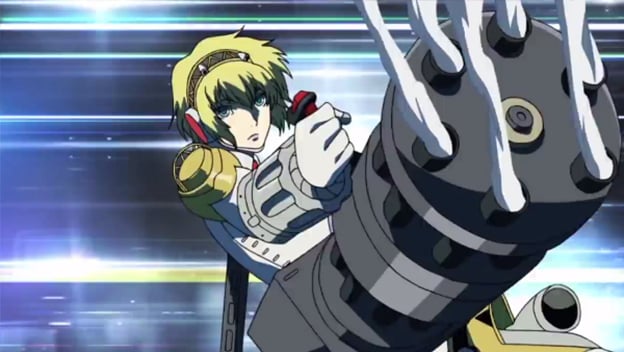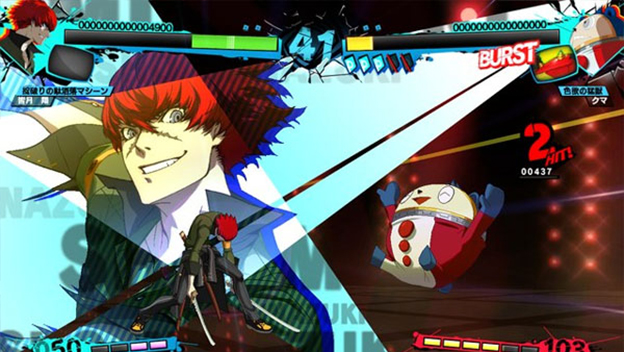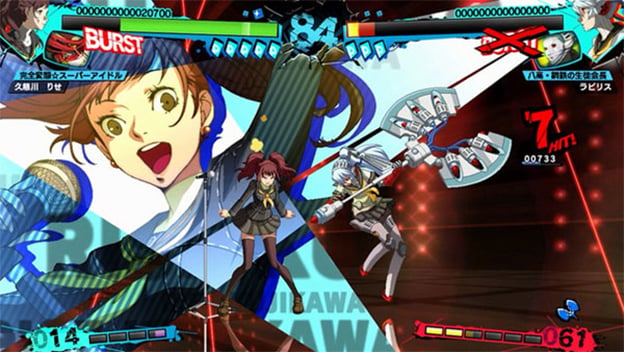Definitley a Sequel
Persona 4 Arena Ultimax is out, and I’d like to rescind something I said in several previews I wrote about the game. Persona 4 Arena Ultimax does not feel just like an expansion pack. There is certainly enough content here to make the game feel like a fully fleshed out sequel. It’s fun and interesting and the balance changes are great. But while Atlus and Arc System Works really hit the nail on the head with some additions to the game, a lot of others seem like just throwaway pieces that at best you’ll never use and at worst greatly complicate an already complicated system. Persona 4 Arena is likely a game worth getting, but with a lot of extras that probably could have been cut in order to work on another character or stage or something.
The most important thing people look for in fighting game sequels is an increased roster, and Persona 4 Arena doesn’t disappoint. The rest of Persona 3 ’s cast, including Junpei, Ken, and Yukari, has joined the battle, along with Rise from Persona 4 , a brand new character called Sho Minazuki with two separate forms, and 3 new DLC characters, Adachi, Margaret, and Marie. That’s 9 new characters in total, which is outstanding for a fighting game sequel. In addition, each character has their own “shadow” version as well, which gives up the ability to burst i.e. break out of combos, in exchange for increased health, a slightly different move set, and the ability to get infinite meter temporarily.
The new characters are very interesting on the whole. Yukari is a dedicated zoner whith huge screen filling arrow beams. Junpei uses a baseball meter to score runs and power up. Rise uses “reflect” style skills that actually reflect physical blows. Ken uses Koromaru the dog and his persona in order to attack from multiple angles at once. They are all really cool and unique and the DLC characters are probably going to be just as awesome.
But there are also some points of needless complication here. Sho Minazuki, for example, has a form with a persona, and a form without a persona that fights more like a traditional fighting game character. While both versions of the character share a lot of moves and normals, they are mapped to different commands. For example, his projectile is mapped to a charge command without a persona and a quarter circle command with! They both look almost identical and the only way to tell them apart on the character select screen, aside from the persona itself, is that one is smiling and one only has a small smirk.

A similar problem occurs with Labrys, who has a normal form, a shadow form, and then a “shadow labrys” form which was the boss from the original game. Having these slight variations on characters with very similar names makes it very, very hard to even discuss them outside the game, much less play them inside the game. It’s a small detail, but it feels sloppy. Even Marvel 2’s Wolverine and Bone Claw Wolverine were hard to mistake for one another, either in the game or in plain speech.
The shadow forms of characters are fun, after all who doesn’t want infinite meter, but in the end they are kind of useless. Nearly across the board, according to professional Japanese players, non-shadow forms are better than shadow forms. This is because the ability to burst out of combos is so valuable, not to mention the move-sets of non-shadow characters tend to be more expanded and flexible. If you are a casual player these are a nice addition, but if you are someone who is looking to win they will go mostly ignored. Also, note that several character, like Elizabeth and Sho, simply don’t have shadow versions.

There are a lot of new system elements introduced into Persona 4 Arena Ultimax as well. Perhaps my most favorite is the addition of, essentially, EX super moves. You can now burn more meter than usual to do powered up versions of your supers, just like in King of Fighters , and it is a great way to burn just a little bit of extra meter for an advantage.
There is also the new “suplex hold” system which doesn’t really have anything to do with throwing an opponent. Instead, when you hold the weak attack button down, a meter will charge. When you release it, you will do a special skill, ex skill, super, ex super, awakened super, or even an insta kill. Basically it’s a one button way to do special moves for people who have problems with quarter circles. The only problem is that it drains far, far, far too slow, and it prevents you from using your weak attack which is arguably your most important attack. Even newbies stop using this after a match, because it is just too slow to be useful.
A system element that I am sort of neutral on is the addition of One More Bursts. Like One More Cancels, One More Bursts cut off the end lag of whatever move you were doing, but instead of simply returning to neutral, it causes the opponent to be popped into the air. In terms of functionality, it’s pretty cool, but it takes up a very specific 3 button combination on the controller, which pushes one more cancel to a very specific OTHER 3 button combination on the controller. On a pad, you basically HAVE to map these to shortcuts on the trigger, but then you still have to map shortcuts for furious action, throw, all-out attack, dodge and short hop, and more. Basically, if you aren’t playing on an arcade stick, you are running out of buttons.
You’ll be happy to know that the balance of Ultimax has been increased exponentially. Problematic characters like Mitsuru and Elizabeth are weaker this time around. Kanji still sucks and Yu is still good in a sort of “generic jack of all trade characters are always good” way but I feel like there are fewer very bad matchups this time around. Of course, the game is still young so who knows how this will end up.
There are a lot of other interesting tweaks as well, including chargeable moves, variable Persona HP bars, tweaked damage rates and character life bars, new combo restrictions and more. Not all of these are plainly visible to someone jumping into the game dry, but they certainly do make for a more balanced experience.
Outside of the core gameplay itself, there are a lot of cool new modes in Ultimax . First of all, the story is incredibly long. Really, really long. Like over 20-30 hours long. Playing it puts you on a branching path of episodes that you can wander around and play at your leisure. Usually you’ll be given 10-15 minutes of talking before a match, with a character that you are forced to play. Depending on what you do in that match, the game progresses in different ways. Story mode, btw, is by default set to a “holy crap this is so easy” difficulty mode that is lower than what you would experience in every other mode in the game. It allows you to just progress through the story at your leisure without needing to flex your fighting game muscles much.

There is also a new Golden Arena mode, which plays out kind of like an RPG. You choose a character and start going through dungeons, fighting opponent after opponent, and gaining levels. As you level up and increase your social link with a navigator of your choosing, you’ll increase your stats, and gain new passive skills to aid you in battle. It’s a lot like Soul Calibur ’s goofy multi weapon arena modes, and it’s a fun little diversion.
Unfortunately, the thing I was most excited about I can’t really review. Ultimax ’s multiplayer online lobbies are basically set up like a virtual arcade. You control an avatar, walk up to a machine, place a quarter down and wait your turn, and so forth. It’s cool, but at time of writing the only people playing online were other game journalists so I really couldn’t tell you whether it works well or not.
In the end, I think Persona 4 Arena Ultimax is a good game, well worth a purchase if you bought the original, and definitely worth a purchase if you didn’t. It’s a fun and balanced fighting game with a lot of nuances. It’s just very complicated and hard to get into if you are only a casual player, and the steps taken to make it easier to understand, like the “suplex hold” system, really only serve to complicate matters further. The sixty dollar price tag is a bit much to take, especially if you already spent sixty dollars on the original two years ago, but if Persona 4 Arena has been a staple in your fighting game library, Ultimax gives you more than enough content to satisfy you for another two years, and hopefully with patches and DLC it will get even better.
RATING OUT OF 5 RATING DESCRIPTION 4.0 Graphics
It’s nice to see the rest of the Persona 3 cast join the fight. 2.5 Control
There are way, way, way too many button combinations to keep track of, and without an arcade stick you’ll quickly run out of space on the controller. Also combo timing is needlessly finicky. 3.5 Music / Sound FX / Voice Acting
The English voice acting is ok, but I prefer to listen to the Japanese voice track. 4.0 Play Value
When it was first announced I was angry that I would have to purchase the game again, but it’s probably worth the sixty dollar price tag. 3.7 Overall Rating – Good
Not an average. See Rating legend below for a final score breakdown.
| Review Rating Legend | |||
|---|---|---|---|
| 0.1 – 1.9 = Avoid | 2.5 – 2.9 = Average | 3.5 – 3.9 = Good | 4.5 – 4.9 = Must Buy |
| 2.0 – 2.4 = Poor | 3.0 – 3.4 = Fair | 4.0 – 4.4 = Great | 5.0 = The Best |
Game Features:
